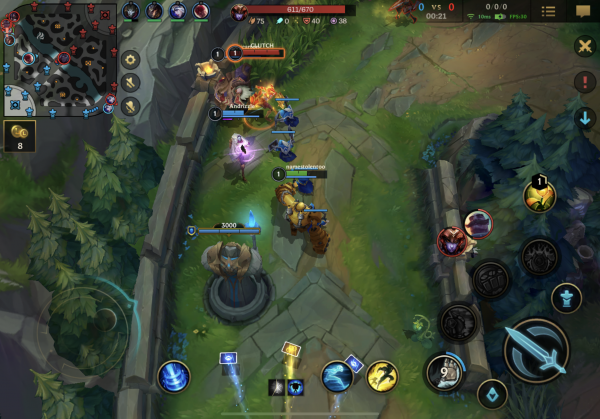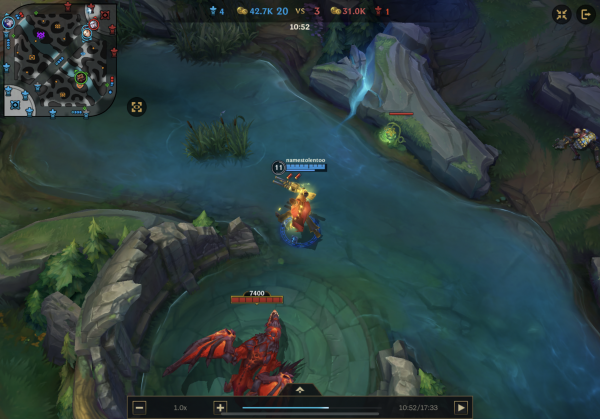A Scrub's Guide to League of Legends: Wild Rift - Breaking Down the Meta - Team Comps
Like all popular competitions, League of Legends: Wild Rift has developed a set of unwritten rules about how to play it well. These rules are known as the metagame or "meta," and understanding why they exist and how to take advantage of them is a key step in becoming a truly competitive player.
The most important aspect of the meta to pay attention to at the moment is team composition. If you've already sunk some time into Wild Rift, it's probably been made clear to you that there are certain hero combinations that are more effective than others. Teams with players who simply pick their favorite heroes tend to be unbalanced in one way or another, and you'll likely either see that reflected in team performance or through one or more teammates complaining about the composition in chat.
While it's true there are no explicit rules stating that you have to have certain character archetypes on a team, cooperating to have each player fill a specific role leads to a better match outcome more often than not. This is because heroes are designed to be specialists around a subset of objectives in any given match. Separating into distinct roles and playing them well simply ensures your team always has at least one right tool for any given job across an evolving match of Wild Rift. With this in mind, here's a breakdown of roles, their purpose, and some general tips on how to play each one effectively.
Dragon Lane: The dragon lane hero is also be known as the attack-damage carry (ADC), and provides a lot of sustained firepower to your team. This is nearly always a ranged hero who builds up a lot of items to make their basic attacks really powerful. Once built up, ADCs are key for taking down objectives like towers and hanging around the edges of teamfights to pick off enemies one by one. It's critical for ADCs to earn a lot of gold across a match, as they start out quite weak and are an easy target for the enemy team unless they play carefully and are well-protected by their teammates. Even when fully built, ADCs tend to be slow-moving with few defenses, so learning how to position yourself so you can deal a ton of damage and come out of fights or tower pushes alive is key to doing your part for the team. Without an ADC, your team will struggle to destroy towers and lack damage output, resulting in poor teamfighting capability.
Support: As their name implies, support heroes add utility to the team by how they help other roles out. This almost always starts as protection for the ADC as they farm minions and try to build up their damage. Depending on the support hero, this might involve stunning incoming attackers, healing your ADC if they get hurt, or trying to catch the enemy ADC out of position and set your teammate up to get a kill advantage. On top of this, teams look to supports to keep an eye on objectives like dragons, ward key areas of the map, and use their abilities to grant an advantage in initiating a teamfight or to help the team escape from a losing skirmish. Great supports stick to teammates and communicate well to keep the everyone from getting too greedy about kills and instead redirecting energy into taking objectives.

Middle Lane: The middle lane champion is all about flexibility. With the middle lane of the map being the shortest (and literally in the middle of everything else), teams want to have a hero here who can move quickly as needed between different objectives and fights, lend assistance quickly, and then return to their lane to keep control of it before searching for the next opportunity to run off to. As a result, it tends to be a good idea to have high-mobility champions that can do a lot of burst damage (typically through their abilities) here. In teamfights, mid-lane heroes are meant to take huge chunks of health off of enemy heroes with their gear-enhanced skill damage while being careful not to be overwhelmed or bursted down yourself by the enemy team.
Baron Lane: Baron lane champions start out farming and fighting in the lane closest to Baron Nashor, an objective with a powerful buff that only becomes available around the half-way point (10 minute mark) of any given match. Because of the long wait before Baron Nashor is even available, this is more of a slow-paced lane that tends to benefit from having tankier heroes who can sustain themselves in solo encounters or even escape attacks from the enemy jungler. This role stays a mostly one-on-one fight over lane control, but evolves into keeping an eye on Baron Nashor after it spawns to make sure the other team doesn't get it. In teamfights, baron lane heroes are great for diving through the enemy ranks to take out the enemy's ADC. If you’re just starting out with Wild Rift and not sure which role to play, baron lane’s straightforward nature and durable champions is a good place to start.

Jungler: Junglers are a complicated role because they compete for control over the buffs and creeps in every part of the map that isn't a lane, while also trying to catch enemy laners unaware for easy kills typically referred to as "ganks." There's a lot of ground to cover as a jungler given the enormity of non-lane space in the game, and the abundance of brush in this area encourages you to invade, keep tabs on, and steal from the enemy jungler whenever possible. As a result, junglers are typically another high mobility hero, but they also tend to need some tankiness to help them stay alive while clearing jungle camps and rotating between lanes. Junglers tend to dictate a lot of the pace of a match simply by how effectively they hop in to pick on enemy laners or steal resources from the enemy jungler. Jungling involves keep track of a lot of things at once, so it’s recommended to only step into this role once you feel like you have a good handle on all the others.
If you find yourself on a team that doesn't have at least one person playing each of these roles, you cede all of the advantages for the missing role’s objectives over to the other team while also preventing any doubled up roles from reaching their full potential. As mentioned in a previous scrub guide, Wild Rift is a first and foremost a battle over resources, and if you have two players on the same team harvesting from the same resource pool, then they are halving their progression rate.
So, even when playing casual PvP matches, take a look at your team's selections, feel free to soft-lock your preferred champion, but be prepared to switch in order to cover your roles according to Wild Rift's meta. Not doing so will spell disaster unless you get lucky with hyper-competent teammates or an enemy team that is unskilled or otherwise unbalanced.
Looking for more beginner tips for Wild Rift? Check out more of our scrub’s guide here!



